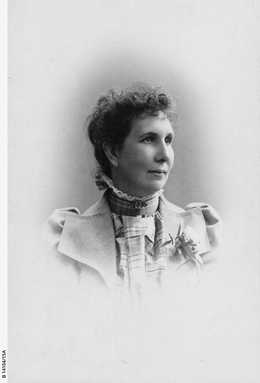Elizabeth Armstrong (artist) facts for kids
Elizabeth Caroline Armstrong (born September 28, 1859 – died February 21, 1930) was an Australian artist and art teacher. She was very important in art education. She was the first woman to teach art at a major art school in Australia. This was at the South Australian School of Design.
Contents
Early Life and Art Training
Elizabeth, also known as Lizzie, was born in Adelaide, South Australia. Her father was James Armstrong and her mother was Mary Ann.
When she was in her early twenties, Lizzie showed her talent. Her watercolour paintings were praised at an exhibition in Adelaide in 1881.
Starting in 1882, she studied art under Louis Tannert. He was the head of the School of Painting. Her artworks were chosen to represent the school in big exhibitions in 1887 and 1888. She also took special courses under Harry Pelling Gill. She earned an art teacher certificate and a top award for painting still-life pictures.
Her Career as an Artist and Teacher
In 1892, Harry Pelling Gill suggested Elizabeth Armstrong become the Painting Mistress. He said she was very skilled and qualified. He also thought a female teacher would be good for the many female students. So, Elizabeth started her teaching job in February 1893.
Elizabeth Armstrong was the first of many important women artists who became teachers at the South Australian School of Arts. Many of her students later became teachers there too. Some famous students included Stella Bowen, Gwen Barringer, and Dora Chapman.
Elizabeth was also known for her beautiful flower paintings. Her painting Hollyhocks was sold at an art show in London in 1898. She also received praise for her paintings Wattle from Sunny New South Wales and Cosmos.
In 1903, the Art Gallery of South Australia bought her oil painting, Ranunculus. A gallery guide later called it a "fine floral study." It was one of her many successful flower paintings. Elizabeth Armstrong is also seen as an early painter of Australian native flowers. Her "majestic" Waratahs from around 1906 is an example.
Elizabeth was also a leader in the art community. She was the first woman to hold an important position in the Society of Arts. She was Vice-President from 1923 to 1928. She was also president of the Art Club from 1918 to 1920.
From 1913 to 1914, she took a break from teaching. She traveled to London, France, Italy, and Russia. She visited art schools and galleries there. After her trip, she gave talks about international art to different groups.
Teaching was very important to Elizabeth. She taught at the School of Arts and Crafts for over 36 years. She only stopped when she turned 70, which was the age for required retirement.
How She Is Remembered
Elizabeth Armstrong passed away unexpectedly in England on February 21, 1930. She had a stroke. Her ashes were later brought back to Adelaide. They were placed in her nephew's grave at West Terrace Cemetery.
Later that year, a portrait of Elizabeth was shown at the School of Arts and Crafts. Her former student and colleague, Beulah Leicester, painted it. The school magazine said the portrait hung in the painting room. This room was always known as "Miss Armstrong's room." It reminded everyone of her kindness and charm.
Students and staff built the Elizabeth Armstrong Memorial Library. It was made of European oak wood. The library opened in September 1936. When the old art school building was taken down in 1962, this library was saved. It was moved to the new art school. It kept her memory alive for many years.
Notable Works
- Ranunculas c.1903, Art Gallery of South Australia.


